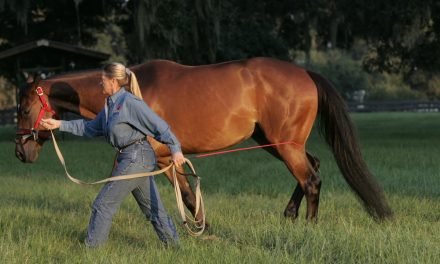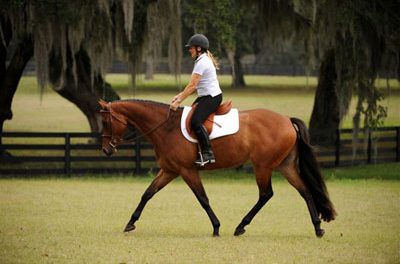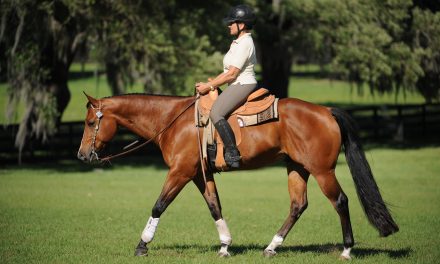Building A Partnership With Your Horse
 There are several common difficulties riders may encounter when training on the trail, and one typical problem is the horse who always wants to be in front. The horse that always wants to be “the leader of the pack” usually has experience being on trail rides with other horses, but he may demonstrate this tendency as early as his first trail ride. Most likely, this characteristic will become more and more of an issue unless his rider learns how to deal with it.
There are several common difficulties riders may encounter when training on the trail, and one typical problem is the horse who always wants to be in front. The horse that always wants to be “the leader of the pack” usually has experience being on trail rides with other horses, but he may demonstrate this tendency as early as his first trail ride. Most likely, this characteristic will become more and more of an issue unless his rider learns how to deal with it.
First of all, the answer is not just getting a stronger bit. This only will intensify the horse’s anxiety and desire to get in the lead. You do not want to end up with a tack room full of bits and a totally frustrated horse and rider!
Do not complicate the scenario by taking this kind of horse out in a large group, which will only over-stimulate him and make him more difficult to work with. Instead, trail ride with only two to four horses at most. Be sure you are riding with people who understand your goals and are willing to work with you. To safely school this type of horse on the trail, you need to ride with people who are generally safety conscious and who do not mind stopping and changing gaits and positions.
A horse that is inexperienced at trail riding or that is in his earliest stages of trail training will be the easiest to train to accept whatever spot on the trail the rider chooses. The key to this training is to have the rider change the horse’s position often on the trail ride. The more the rider does this, the more the horse will accept the rider’s commands and allow his natural instincts to take care of his rider. There are two training methods to accomplish this goal.
Single File Trail Training:
Set up a trail ride training scenario where you and your horse are among two to four horse/rider combinations in single file. Start with your horse in the lead position for a short time of about two to three minutes. Next, shift positions in the line so that he is the second horse. Stay in that position for a short time, and then move him back to the lead. Continue to lead for another short interval, and then shift to the third in line. Hold the horse there for a while, and then take him back up to the second position. From there, rotate into fourth position for another short segment, and then back to third, and so on.
Always start in the lead position. If the horse is in front, he should start to relax in about two to three minutes, and then move him to a different position in the line. Even if he does not relax, rotate him within the trail ride line anyway.
Pairs Trail Training:
Once you have practiced rotating him within a single file line, ask your fellow riders to pair up so that they are riding two abreast. Bring your horse to the lead position with another horse/rider pair. Your horse should begin to relax. Stay in the lead position for two to three minutes, and then, with you partner, rotate into the second position in line. Again, if he does not relax, move him anyway. Stay in the new position for two to three minutes, and then go back to the lead. Continue changing positions throughout the ride.
Other Trail Training Techniques:
Leg Yielding is one of several other techniques that you can use to keep your horse’s attention while you are on a trail ride. When you are riding single file, ask your horse to leg yield to the right side of the trail by using your left leg aid. When you reach the trail’s right edge, go forward, and then ask him to yield back to the left edge. Do these maneuvers in short segments and in both directions.
Transitions can be mixed in with the short segments of yielding to teach the horse to keep his attention on you. Examples of simple transitions to use include: walk to trot, trot to walk, walk to lengthening walk, trot to lengthening trot to slow trot. The more the rider does short segments of changing the horse’s position, riding in pairs, yielding, and simple transitions, the more the horse concentrates on the rider rather than following his herd instincts.
Stopping is always a good option if the horse starts to get anxious while training on the trail, as well as being a good training tool in itself. If the horse jigs around when you ask him to stop, get off. Spend some time with him on the ground until he relaxes. When he does relax, get back on and resume the trail training process. If he does not relax, he is telling you that he has inner energy that needs to be released. This probably means he was not prepared enough for the lesson. You may need to walk him back to the barn, especially if the situation is making you fearful, nervous, or frustrated. On the trip back to the barn, do in-hand maneuvers such as turn on the forehand, turn on the haunches, backing, and leg yielding. These maneuvers will help the horse learn to focus more of his attention on you.
Safety First Always!
While practicing these trail training lessons, keep these safety precautions in mind:
1. When riding in a group or with only one other person, always call out to the other rider(s) what you are going to do, or designate one person on the ride to call out each short segment. Always make sure everyone is ready for what is coming.
2. When riding in single file, keep at least one horse length distance (eight to ten feet) between horses. When riding in pairs, respect the same distance between partners and the horses in front. Many trails are too narrow to allow this distance between riding pairs. Therefore, it is important for riders to learn to read their horse’s ears and body language to determine if he accepts the other horse and rider in close proximity.
3. Always keep the one horse length distance rule, especially on trails where turns do not allow the horse in back to see the horse in front of him. A horse will not always accept this situation, and he naturally will want to run to be within sight of the horse in front. It is good trail etiquette for a rider in the lead to slow down around a turn to allow the rider(s) behind him to remain one horse length behind. The rider who is behind should ask the lead rider to slow down in order to keep the lead horse within view of his/her mount.
In the next article, I will discuss some other common problems you may encounter on the trail. In the meantime, my E-Book, Training Outside the Box, is available online at www.lynnpalm.com along with other valuable training products. You also may contact us at 800-503-2824





